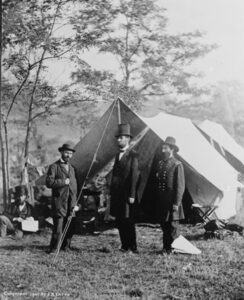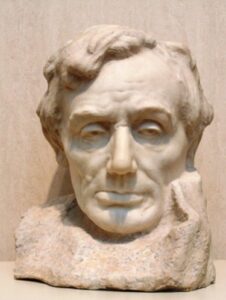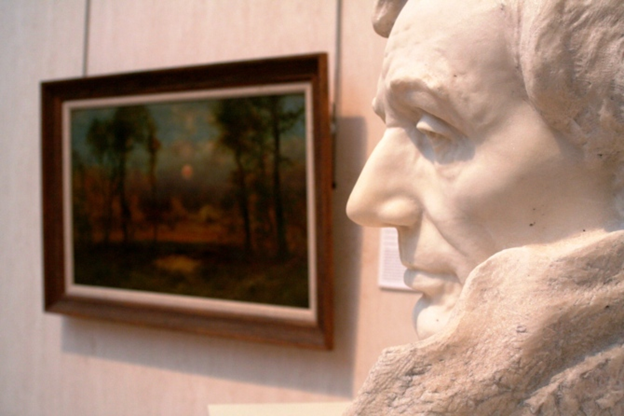Located in an honored place in the United States Capitol building is a monumental bust of Abraham Lincoln, sculpted in 1908 from a single block of marble by the artist John Gutzon Borglum (1867–1941)—best known for his colossal Mount Rushmore sculpture. Later bronze casts of the bust can be found in the collections of the White House, the Chicago Historical Society, the College of the City of New York, and the Tomb of Lincoln in Springfield, Illinois.
But most people do not know that the only half-sized marble version of this important work of art is part of the collection of the Washington County Museum of Fine Arts. Commissioned by museum founder Anna Brugh Singer, it was the very first work of art accessioned into the museum’s permanent collection in 1931. A resident of Olden, Norway, Mrs. Singer arranged with the sculptor to complete a half-sized version for the new museum in her hometown of Hagerstown.
This sculpture is an important work of art, not just for the region, but for the nation and the world. Although Washington County’s history is rich in the colonial and French & Indian War eras, the Battle of Antietam on September 17, 1862, was certainly the most defining event in its history. Residents of Washington County experienced anxiety, starvation, death, destruction of property, separation from loved ones, diaspora of the community, and irrevocable change as a result of the battle. With some 23,000 casualties, the Battle of Antietam stimulated a chain of events that led President Abraham Lincoln to issue the Emancipation Proclamation.

Lincoln walked the hallowed ground of Antietam a few weeks after the battle, in October 1862. He urged General George B. McClellan to pursue General Lee in order to make short order of the rebellion, restore the Union and save the lives of thousands more who would die in battle. During his visit to Washington County, Lincoln was reeling from unimaginable personal trauma—the death of his son William earlier in the year—and was shouldering the responsibility of ending a cruel conflict between brothers, neighbors, and races. Gutzon Borglum’s portrayal of Lincoln captures the inner turmoil he suffered, yet reveals his staunch character and enduring concern for others.
Elizabeth Johns, professor emerita of art history at the University of Pennsylvania wrote of the Washington County Museum of Fine Arts’ sculpture: “Gutzon Borglum’s sculpture Head of Lincoln reveals his close study of photographs of the President. The knit brows, hooded eyes, full lower lip, sunken cheeks, and even the wart on his cheek place the brooding man before us. Carving the head directly into the stone, Borglum emphasized the right side of Lincoln’s face, which he considered the more expressive. The sculpture, created more than sixty years after the end of the Civil War and by an artist who was born after the war, is a testimony to society’s enduring preoccupation with Lincoln. Known for his monumental sculpture carved into Mount Rushmore, Borglum considered this portrait as among his finest work.” Read her full essay here

I invite you to visit the Washington County Museum of Fine Arts this spring and spend time in contemplation of the Head of Lincoln, which is but one of the prized treasures of this nationally accredited museum. The museum is open Tuesday through Sunday, admission is free and the public is welcome. For more information about visitor services, exhibitions and programs, contact the museum at 301.739.5727 or www.wcmfa.org.
Photos:
John Gutzon Borglum, American (1867-1941)
Head of Abraham Lincoln
1930
Marble
Gift of Mrs. Anna Brugh Singer, Olden, Norway
“Antietam, Md. Allan Pinkerton, President Lincoln, and Maj. Gen. John A. McClernand,” Alexander Gardner photograph, from the Library of Congress LC-DIG-cwpb-04339.

